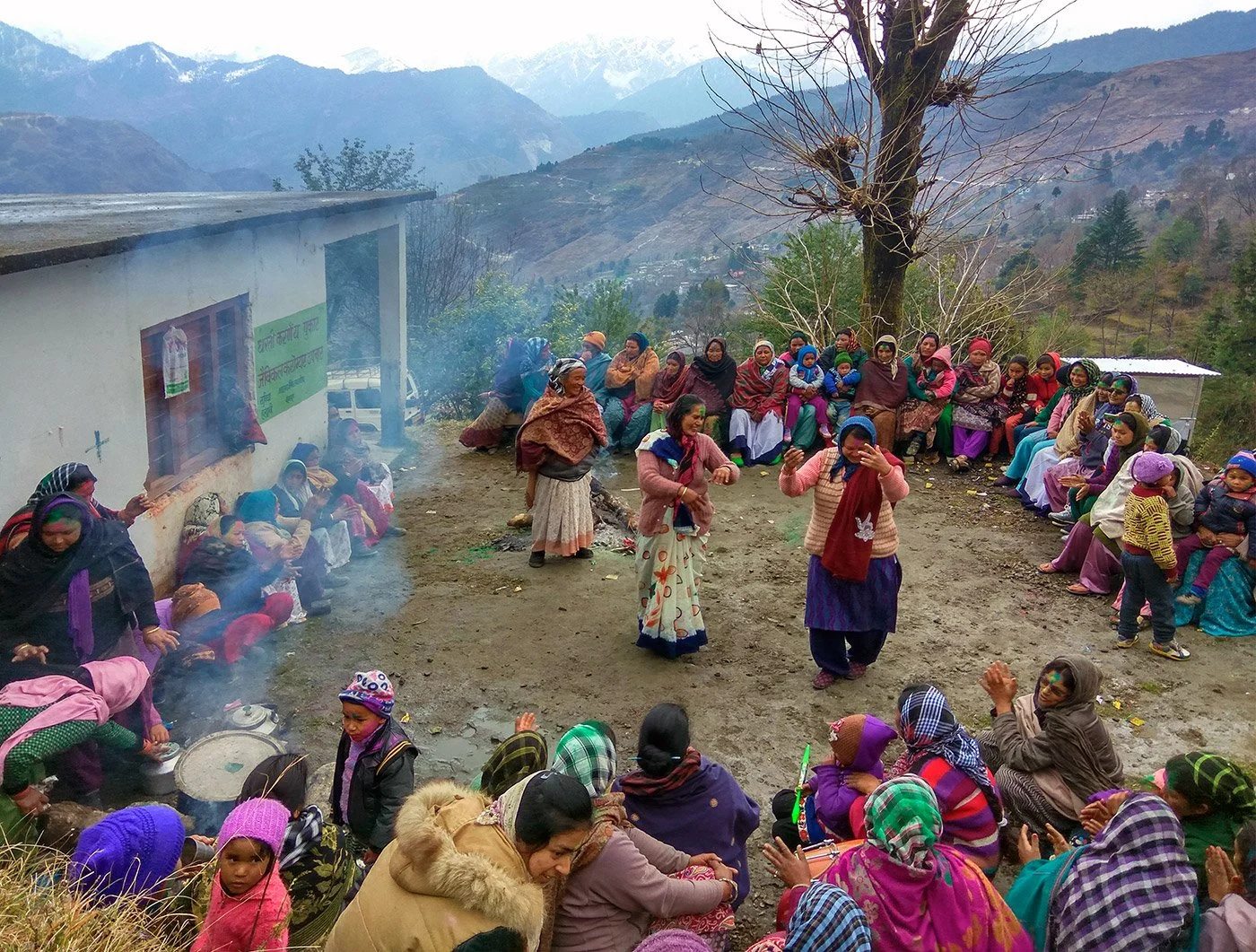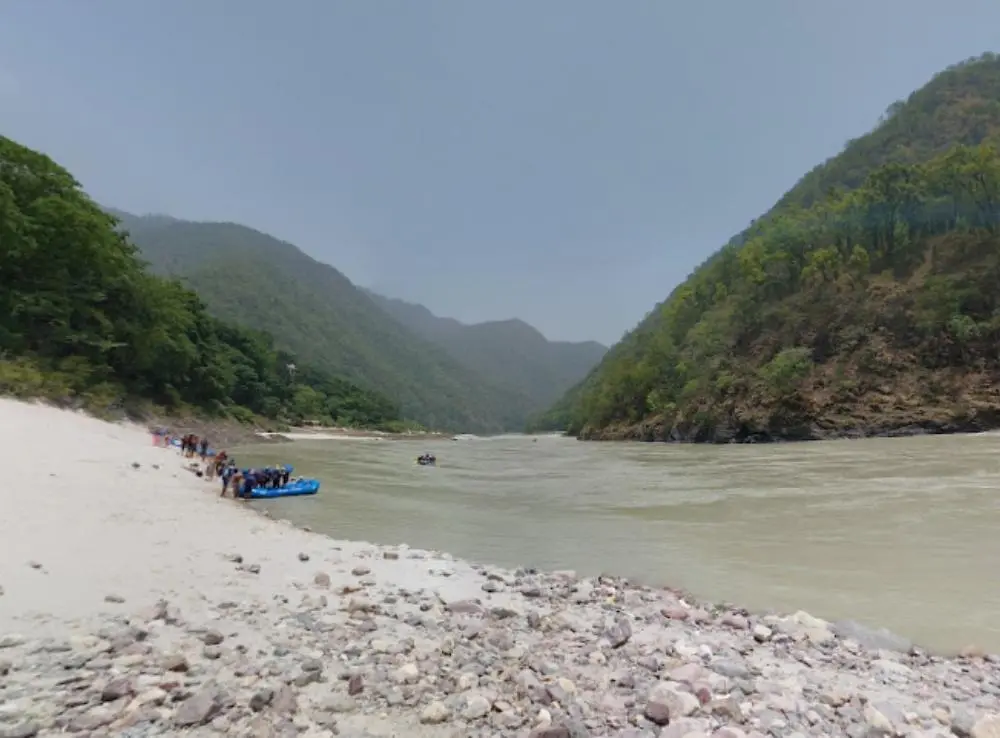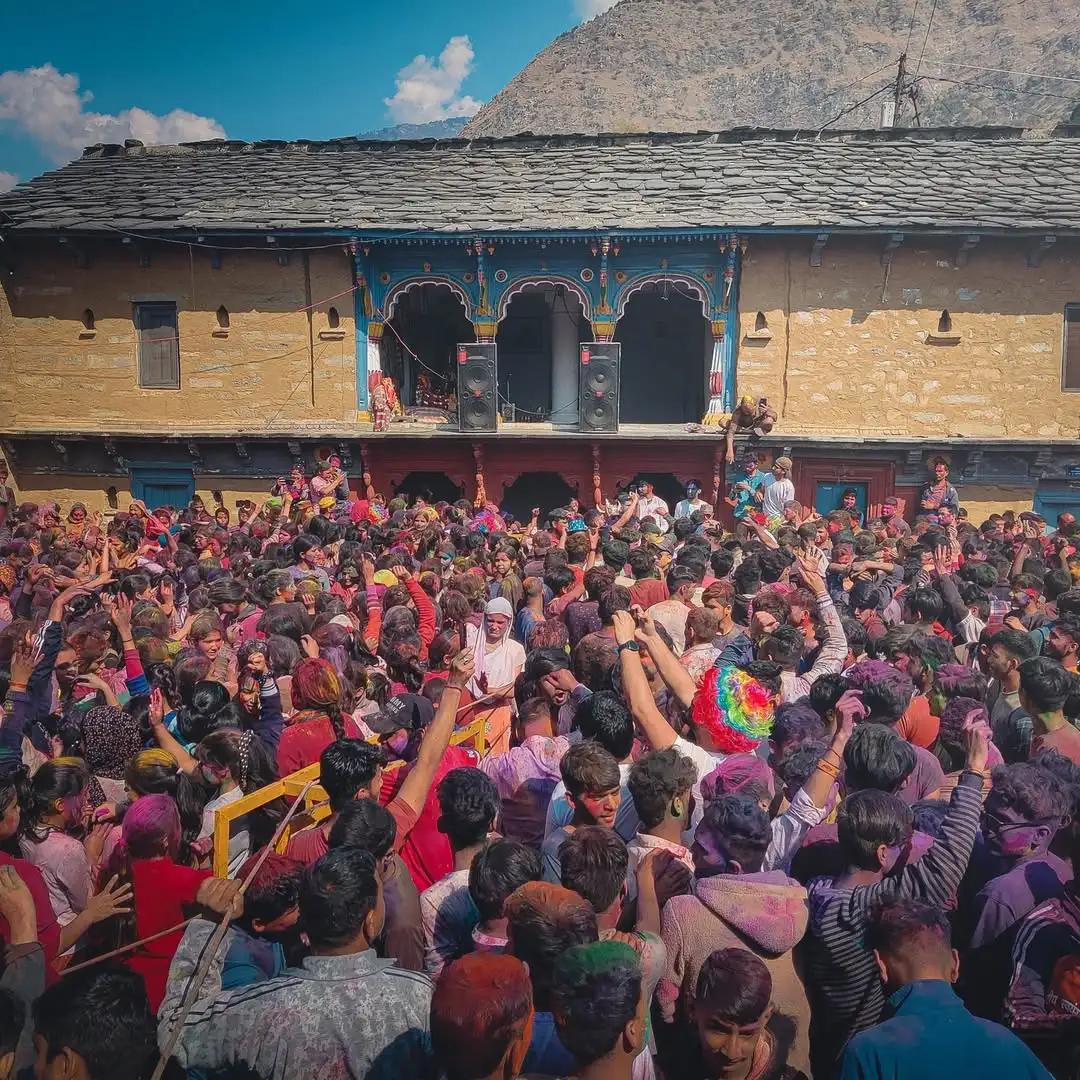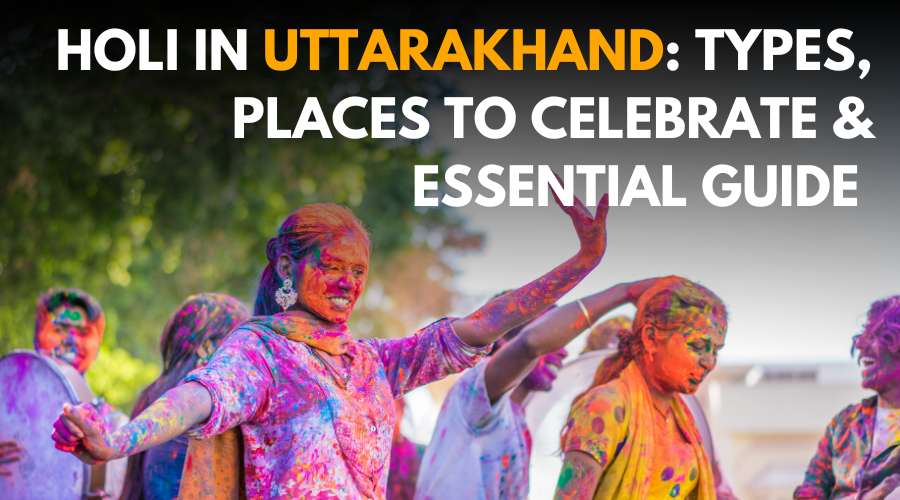Holi is a festival that brings spirit and joy to people of all ages. However, if we look beyond its festive aspects, it holds a deep spiritual meaning. The mythological belief says that Holi signifies the victory of good energy over evil deeds.
The region of Uttarakhand, which is also referred to as a Devbhoomi, meaning “the place where the gods reside”, marks grand celebrations of Holi. Holi in Uttarakhand is honored not only as a festival of vibrant colors but also as lively musical fests and events.
Similar to other parts of India, as the spring season sets in, it ushers in a cheerful atmosphere along with the arrival of Holi festivities. According to the Hindu calendar, Holi is celebrated in the month of Phagun on the auspicious day of its Purnima.

Now, due to the presence of diverse communities, traditions, and cultures in the Himalayas of Uttarakhand, the ways of celebrating Holi are rich and varied. In different parts of Uttarakhand, Holi is known by different names as well.
The most well-known pahadi Holi, called the Kumaoni Holi, has three distinctive forms: the Baithki Holi, the Khadi Holi, and the Mahila Holi. The Kumaon region in itself presents a vivid backdrop for Holi with the bloom of rhododendron flowers, lush green landscapes, and breathtaking views.
Through this article, we will explore the different varieties of Holi celebrations in various parts of Uttarakhand State and the best places to celebrate it.
Table of Contents
Types of Holi in Uttarakhand:
The Uttarakhand state is categorized into two different regions: the Kumaon and the Garwahal. The division is based on their mountainous zones, climate, culture, rituals, cuisines, and several other factors.
Consequently, slight contrasts can be seen and experienced in the celebration of Holi between these regions as well.

Kumaoni Holi:
The Kumaoni Holi is the most awaited among the locals and travelers alike. It is organized as a community gathering where there is no room for hatred, differences, or hostility. This celebration marks the end of the winter season and the appearance of the crop season.
The different forms of Kumaoni Holi played, following different customs and rituals are the reason that makes these celebrations unique.
a) The Baithaki Holi:
The Baithki Holi represents itself in the form of a spiritual and classical music festival. Although the pleasant festivities typically begin with the first Sunday of the Paush month, however, some areas remarkably start their celebrations on the day of Basant Panchami.
The Baithaki Holi is played not for colors only but also to relish the old traditions and cultures of Kumaon that have been running for ages and are a part of their reverence.
The series of this longest-running festival starts in temples where the villagers and Holiyars, the singers of the Holi songs, come together with tabla, trumpet, harmonium, and several other local musical instruments to sing the cultural ragas. These ragas are generally devoted to the Hindu gods and goddesses, especially Rama and Krishna ji.
Each family possesses the right to compose their own Baithaki-holi songs. They do so in the Kumaoni language, and they prefer to sing the songs in their particular dialect. To keep these traditional customs alive forever, the villagers make efforts to teach their younger generation about the significance of these songs.
The residents of the Kumaoni region are very strict about the timings of those melodies to be sung. They have scheduled them based on the ragas they consist of. When the sun is high in the sky, they sing songs with ragas like Sarang, Bhimpalasi, and Pilu. As the evening sets in, they start with Shyamakalan, Jaijwanti, Kafi, and more.
There are numerous musical groups consisting of singers, musicians, etc.; the most popular one hails from the Champawat district, remaining high in demand throughout this four-month festive season.
This Holi is also known by the name of Nirvana ki Holi, which means the Holi of Salvation. It’s believed to be an inter-religious ceremony, participated in by people of all religions and faiths.
Its history dates back to the reign of the Chand dynasty, around the 15th century, which was a very long time ago. It is also thought to have originated in Almora and mostly played in the areas of Haldwani, Almora, and Pithoragarh.
b) The Khadi Holi:
The Khadi Holi, which means the Standing Holi, is a symbolic representation of the culture of the Kumaoni community, of their traditions, rituals, attire, and more. It starts after a while, then the Baithaki Holi.
This type of Holi can primarily be seen in rural areas where the main focus is to showcase the mythological legends through their music, dance, and performances. This is mostly played in Nainital.
In this celebration, the musical ceremonies of the Khadi Holi are mostly managed and executed by women. However, there are men involved, too. They highlight their culture by wearing traditional clothes, including a kurta, churidar, and pointed topi.
Unlike other Holi celebrations, the Khadi Holi features the active participation of women in all rituals and customs. They often portray the art of mimicking, satire, and making humor about societal issues and their personal dynamics that enrich the festive spirit.
As a part of their cultural heritage, they wear customized sarees, play instruments like dhol and manjeera, and dance to their tune.
Moreover, in contrast to the Baithki Holi, the songs of Khadi Holi are rather more Kumaoni folk than the Hindustani classical of Baithki Holi. The group of professional singers of the folk Khadi Holi songs, called the “Toli,” visit the houses of the villagers and sing the song for their growth and prosperity.
The festive dishes of the Khadi Holi mainly include Gujia, Aloo Gutka, and Jamboo (a local Himalayan spice).
Where you see the seriousness in the Baithaki Holi, the Khadi Holi is all about excitement and joy and is full of life.
c) The Mahila Holi:
The craze for the Mahila Holi can be found in the Kumaon region as well. It is very similar to Baithki Holi. However, the domination of the women here is the only difference you can spot.
This is primarily celebrated to show the importance of women in society by allowing them to participate and engage in the Holi festivities.
As the ancient sources display, it is believed to have started from ancient traditions that were heavily male-dominated before. It signifies the community bond between the women and empowers them to manage things on their own.
They gather in one place play with colors and perform dances and traditional music.
Garhwali Holi:
When discussing Holi in the Garhwal region, it’s notable that the Garhwali Holi also has an older history of existence. The local people express the cultural significance of the region through their folk music, dances, and cultural art during the celebration of the Holi, highlighting its importance even in the eras of Dwaparyug and Tretayug. In villages, people start with the worship of their local deities, then people get together in Panchayat Chowk, Dhol, and Damau is brought and then the celebration starts.
Best Holi Celebrations in Uttarakhand:
There are a few towns in Uttarakhand that organize exemplary Holi fests, let’s consider them one by one.
1) Rishikesh:
The Rishikesh is the heart of Uttarakhand, interconnecting all the towns and major cities of the state. As a prominent religious hub, Rishikesh hosts grand Holi parties, which draw the public from almost all over the world. The city seamlessly combines the commemoration of Holi with spiritualism.
The celebration blossoms in the entire city and fills it with joy and liveliness. The thrill of Holi is amplified when you are in the open-air environment, surrounded by a multitude of unknown faces.

The major hotspots of Rishikesh where you must head to celebrate Holi are:
- Ram & Laxman Jhula:
These classic bridges receive an unruly crowd during Holi. They serve as spiritual centers as well as major attractions. Alongside their lanes, there are seen a large number of people playing with colors and dancing to live DJs.
- Camping Sites:
Riverside campsites can also be the best alternative, as they offer multiple packages, including meals, stay, rafting, and participation in the Holi parties.
- The Ashrams:
Rishikesh is home to numerous ashrams that promote a more decent and serene celebration of the festival. The saints and the visitors engage in yoga, use natural colors, meditate, and worship the gods.
2) Haridwar:
Haridwar is treated as a sacred center in Hinduism, comprising multiple ancient temples and other religious site. The Holi in this city is quite popular among the citizens, and hence, the place receives crowds from worldwide.
On the bank of the Ganga river, the Har ki Pauri Ghat is often covered with bright-tone colors during Holi. To make a memory to relish for a lifetime, you can also experience the world-famous Ganga aarti at the Ghat.
In the evening, the main Mahotsav begins when priests performing all the necessary rituals, followed by the Ganga aarti. Afterward, they light up numerous diyas and set them afloat in the Ganges.
The attendees play with dry colors and offer Prasad milk and flowers to the Ganga as a sign of their respect for the river.
3) Dehradun:
The excitement of Holi can be seen at every nook and corner of the Dehradun city. It gears up for the great celebration every year as the city calls a bigger mob, due to its status as the oldest city and the winter capital of Uttarakhand.
For revelers, there are uncountable party bashes at every resort, lawn, farmhouse and various venues where the celebration of Holi often comes in a whole package, including meals, dj system, and accommodation, depending on your preferences. The Doon Music Festival committee organizes these Holi parties.
To attend these events, you can buy their tickets online or offline, either through their personal website or by using applications like BookMyShow and such.
4) Pithoragarh:
Pithoragarh district, consisting of over a thousand or more villages. We see the hues of Holi in Pithoragarh as a lively affair of colors, music, dance, and entertainment. The distinct forms of Kumaoni Holi—the Baithki, Khadi, and Mahila Holi—are more prevalent among the villagers here.
From JhulaGhat to Dharchula, the entire town gets immersed in vibrant colors as the Holi festivities unfold. To understand deeply about the Kumaoni culture, Pithoragarh offers a great opportunity to celebrate this season’s best Holi.
Having said that, at least up to 100 villages of Pithoragarh, due to their personal beliefs and customs, refrain from celebrating Holi, as they believe the colors of Holi might transform their land into an unholy place. Moreover, they believe the Holi festivities could make their local deity upset, which eventually would result in Chilpa Kedar.
Chilpa Kedar is a local term used for unfortunate events.
5) Gopeshwar:
The Gopeshwar Holi is known across the entire world. Every year, thousands of tourists visit here specifically to partake in its Holi celebrations. These festivities are typically held at the Gopinath temple. The celebrants joyfully drench each other using dry and organic colors, which are mostly made from flowers.
What makes the Gopeshwar Holi so iconic is the spirituality of the temple and the old-ancient traditions of the region. The locals here are incredibly heartwarming and always serve their visitors with a kind hospitality that enhances the charm and fun of the Holi.

6) Almora:
Almora has a deep-rooted history of Holi celebrations and features all three forms of Kumaoni Holi, but the Baithki Holi is much cherished and loved by the residents of Almora.
From youngsters to older people, everyone participates in the Holi and dances enthusiastically to the beats of dhols and folk music. They adorn their houses similarly to Diwali and start the festivities from Basant Panchami onward.
Famous Holiyars of the region visit village to village, singing popular songs and promoting their culture simultaneously. On the Purnima night, they light the Holika, and on the following day, they play with different colors as one community.
These are the famous holi that are celebrated in Uttarakhand. If you have any experience to share then please share below in the comments section.

Leave a Comment